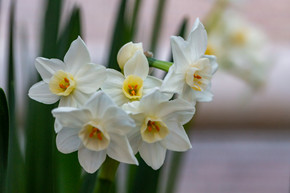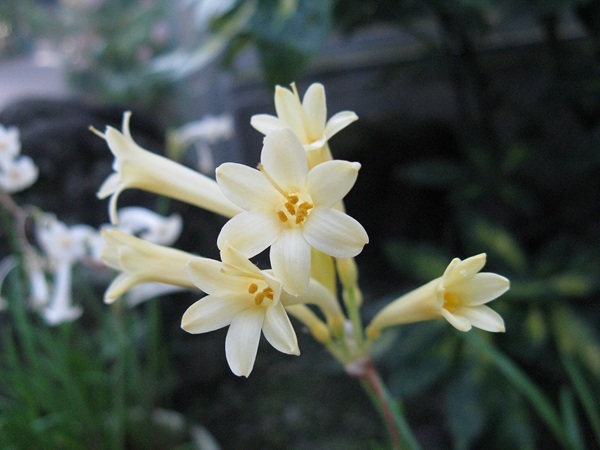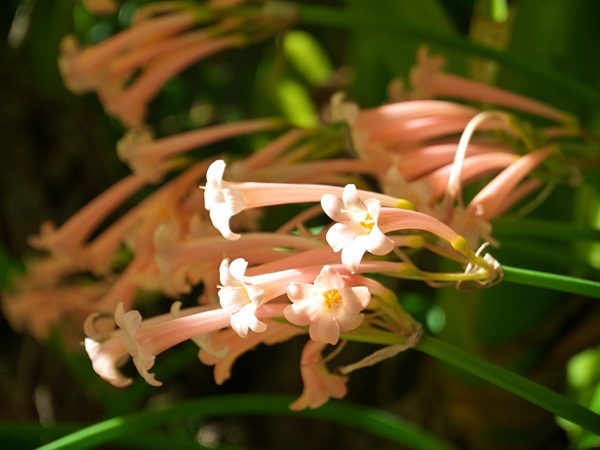

Blooms and Foliage: You can choose blooms in red, cream-white, or Himalayn Pink. The blooms will begin around June in zone 8 and last for 2-3 weeks. Each bloom stalk carries multiple flowers that open in succession, extending the overall display to 2–3 weeks per stem. As the days get shorter and cooler in October, the foliage will begin yellowing and going dormant around November in zone 8 and 9. In ideal conditions in the warmer zones of 10 and 11, this can be semi-evergreen and flower multiple times per year. Otherwise, the foliage can begin to emerge as early as April. Blooms will show up around March. Regular light feeding and watering can reduce the stress on the bulbs and encourage it to bloom more often. You can also deadhead the spent flowers to encourage more bloom spikes.

Mulitplying:
Cyrtanthus mackenii is easy to propagate. It produces offsets (daughter bulbs) readily, which can be separated from the parent bulb when they're large enough—typically in early spring. Take care not to let the fleshy perennial roots dry out; replant the bulbs immediately and water them thoroughly.
You can also grow Cyrtanthus mackenii from seed. After blooming, if the flowers were pollinated, the plant may produce little seed pods. These pods will split open to release flat, papery seeds which are easy to collect. You can either scratch the seeds into the ground and wait to see if they produce new growth over the next 2-3 years, or you can sow seeds in early spring using a deep seed tray filled with the same soil mix recommended for mature bulbs. Lightly cover the thin, black, papery seeds with 3–4 mm of soil, and keep them moist using a gentle spray. Fresh seeds usually germinate within four weeks, and under ideal conditions, the seedlings may begin to flower by their third growing season.

Animals: Many pollinators love these flowers for their deep pollen and nectar. Bees, butterflies, and even hummingbirds enjoy these flowers. However, the deer and rabbit do not so feel free to plant them and enjoy!
* The picture of the white cyrtanthus mackenii is used with permission by Kenpei on Wikimedia Commons, used under CC BY-SA 4.0 Link to license: https://creativecommons.org/licenses/by/4.0/
Blooms and Foliage: You can choose blooms in red, cream-white, or Himalayn Pink. The blooms will begin around June in zone 8 and last for 2-3 weeks. Each bloom stalk carries multiple flowers that open in succession, extending the overall display to 2–3 weeks per stem. As the days get shorter and cooler in October, the foliage will begin yellowing and going dormant around November in zone 8 and 9. In ideal conditions in the warmer zones of 10 and 11, this can be semi-evergreen and flower multiple times per year. Otherwise, the foliage can begin to emerge as early as April. Blooms will show up around March. Regular light feeding and watering can reduce the stress on the bulbs and encourage it to bloom more often. You can also deadhead the spent flowers to encourage more bloom spikes.

Mulitplying:
Cyrtanthus mackenii is easy to propagate. It produces offsets (daughter bulbs) readily, which can be separated from the parent bulb when they're large enough—typically in early spring. Take care not to let the fleshy perennial roots dry out; replant the bulbs immediately and water them thoroughly.
You can also grow Cyrtanthus mackenii from seed. After blooming, if the flowers were pollinated, the plant may produce little seed pods. These pods will split open to release flat, papery seeds which are easy to collect. You can either scratch the seeds into the ground and wait to see if they produce new growth over the next 2-3 years, or you can sow seeds in early spring using a deep seed tray filled with the same soil mix recommended for mature bulbs. Lightly cover the thin, black, papery seeds with 3–4 mm of soil, and keep them moist using a gentle spray. Fresh seeds usually germinate within four weeks, and under ideal conditions, the seedlings may begin to flower by their third growing season.

Animals: Many pollinators love these flowers for their deep pollen and nectar. Bees, butterflies, and even hummingbirds enjoy these flowers. However, the deer and rabbit do not so feel free to plant them and enjoy!
* The picture of the white cyrtanthus mackenii is used with permission by Kenpei on Wikimedia Commons, used under CC BY-SA 4.0 Link to license: https://creativecommons.org/licenses/by/4.0/